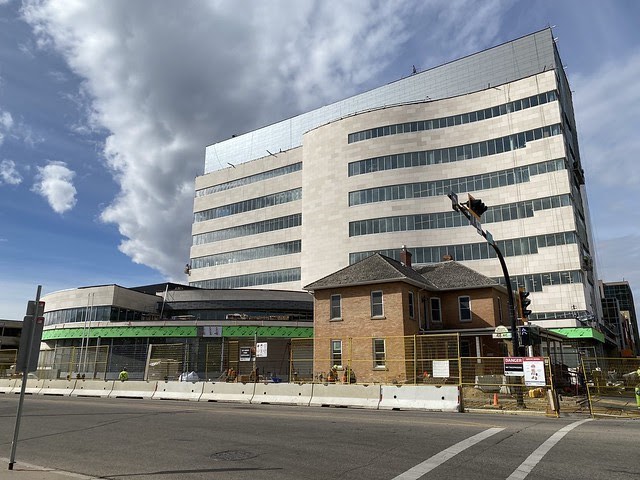Alberta
Province adding 22 ambulance crews including 1 in Red Deer

Adding new EMS supports to improve response times
Record investments will build a stronger, more flexible and innovative system for emergency medical services (EMS) with better access to care and shorter wait times.
Alberta’s government promised that help is on the way for Albertans and the province’s health system. By hiring more staff, putting more ambulances on the road and strengthening mental health supports for front-line workers, Alberta’s government is delivering on that promise.
“We are adding new ambulances and front-line staff and investing in solutions now and into the future to make sure ambulances arrive as fast as possible when Albertans call 911 for a medical emergency.”
The funding boost also supports implementing Health Care Action Plan priorities and recommendations made by the Alberta EMS Provincial Advisory Committee to improve EMS response and the work culture for EMS staff.
Alberta has the best front-line health care workers in the world, and Budget 2023 will put the right supports in place to ensure Albertans get the care they need, when and where they need it.
“Budget 2023 delivers the needed support to the front line and adds more resources to implement the Alberta EMS Provincial Advisory Committee recommendations. The additional funding will help ease worker fatigue and provide more mental health supports to improve the work environment for all EMS staff.”
Adding EMS staff and more ambulances
To improve EMS response time, Budget 2023 invests in adding staff and boosting the number of ambulances on the road. The funding increase will add EMS crews to staff 10 more ambulances in Edmonton, 10 in Calgary, one in Lethbridge and one in Red Deer during peak hours this year.
As part of the ongoing work to improve the central dispatch system and implement the EMS advisory committee’s recommendations, Alberta’s government will provide more than $1.5 million to hire and train additional staff and conduct a review of EMS available resources and how they are used in communities.
Supporting EMS workforce
Front-line staff and community partners asked for more supports to create better work environments, as reflected in the provincial advisory committee’s recommendations. Budget 2023 delivers funding to improve scheduling practices to allow for more breaks, more flexibility in the length of shifts and opportunities to take time off, in addition to providing for more training and development opportunities.
Nearly $1 million will go towards boosting mental health supports for EMS staff across the province. A $3-million investment will address paramedic fatigue in rural communities by adjusting work hours and shift schedules as part of the AHS EMS hours of work initiative.
“This funding increase enables aggressive action on our priority of improving emergency response times. We will hire more staff, increase hours of ambulance capacity, expand partnerships with other community supports and deliver innovative projects. This is about getting Albertans the care they need, where and when they need it.”
EMS-811 shared response, inter-facility transfers and treat and refer
Alberta’s Health Care Action Plan is helping to speed up EMS response times and free up highly trained paramedics from non-emergency calls and transfers. Additional funding will go towards the EMS-811 Shared Response program that transfers calls from Albertans with non-urgent conditions to registered nurses with Health Link.
All these actions will reduce EMS response time by empowering paramedics to focus efforts on urgent calls and diverting them away from situations when their level of care is not medically required.
Medical first response supports in rural communities
Medical first responders provide life-saving care in rural and remote communities until an ambulance arrives. Budget 2023 invests in supporting medical first response and implementing the EMS provincial advisory committee’s recommendations to add capacity and provide additional training and equipment.
Budget 2023 secures Alberta’s future by transforming the health care system to meet people’s needs, supporting Albertans with the high cost of living, keeping our communities safe and driving the economy with more jobs, quality education and continued diversification.
Quick facts
In 2023-24, Alberta’s government is providing $723 million in operating funds for EMS, an increase of $138 million to support EMS priority actions, including:
- $47 million for additional EMS capacity to put more ambulances on the road, hire additional paramedics and emergency communications officers, and create dedicated inter-facility transfer capacity in Edmonton, Calgary and Red Deer.
- $24 million for recruitment and workforce initiatives and supports, including training programs and mental health supports for front-line staff.
- $24 million to continue initiatives that were implemented last year such as the 19 additional ambulances in Calgary and Edmonton, and enhanced scheduling changes made in high-priority stations around the province to reduce paramedic fatigue.
- $21 million for ground ambulance contract changes, increased mileage and fuel, including for air ambulance/air ambulance supports and other operational pressures from the increase in the number of events.
- $7 million to support strategies to enhance the EMS system, such as enhancements to the medical first response program, public education and response, and a review of the ground ambulance resource allocation policies and capacity.
- Almost $7 million to support other initiatives such as clinical improvement initiatives like expanding the vital health response program to the south zone, which will make it possible for paramedics to provide life-saving heart medication in the event of a heart attack, and expanding the mobile integrated heart program to support community paramedics across the province.
- $3 million for the EMS-811 Shared Response program.
- $3 million for other initiatives related to implementing recommendations.
- $2 million for a project related to air ambulances.
- Budget 2023 provides $196 million in new EMS funding over three years to hire more staff, put more ambulances on the road and implement recommendations made by the EMS advisory committee and the EMS Dispatch Review Report.
- In addition, $15 million over three years will fund a new capital program to purchase more ambulances and related equipment.
Alberta
Red Deer Justice Centre Grand Opening: Building access to justice for Albertans

The new Red Deer Justice Centre will help Albertans resolve their legal matters faster.
Albertans deserve to have access to a fair, accessible and transparent justice system. Modernizing Alberta’s courthouse infrastructure will help make sure Alberta’s justice system runs efficiently and meets the needs of the province’s growing population.
Alberta’s government has invested $191 million to build the new Red Deer Justice Centre, increasing the number of courtrooms from eight to 12, allowing more cases to be heard at one time.
“Modern, accessible courthouses and streamlined services not only strengthen our justice
system – they build safer, stronger communities across the province. Investing in the new Red Deer Justice Centre is vital to helping our justice system operate more efficiently, and will give people in Red Deer and across central Alberta better access to justice.”

Government of Alberta and Judiciary representatives with special guests at the Red Deer Justice Centre plaque unveiling event April 22, 2025.
On March 3, all court services in Red Deer began operating out of the new justice centre. The new justice centre has 12 courtrooms fully built and equipped with video-conference equipment to allow witnesses to attend remotely if they cannot travel, and vulnerable witnesses to testify from outside the courtroom.
The new justice centre also has spaces for people taking alternative approaches to the traditional courtroom trial process, with the three new suites for judicial dispute resolution services, a specific suite for other dispute resolution services, such as family mediation and civil mediation, and a new Indigenous courtroom with dedicated venting for smudging purposes.
“We are very excited about this new courthouse for central Alberta. Investing in the places where people seek justice shows respect for the rights of all Albertans. The Red Deer Justice Centre fills a significant infrastructure need for this rapidly growing part of the province. It is also an important symbol of the rule of law, meaning that none of us are above the law, and there is an independent judiciary to decide disputes. This is essential for a healthy functioning democracy.”
“Public safety and access to justice go hand in hand. With this investment in the new Red Deer Justice Centre, Alberta’s government is ensuring that communities are safer, legal matters are resolved more efficiently and all Albertans get the support they need.”
“This state-of-the-art facility will serve the people of Red Deer and surrounding communities for generations. Our team at Infrastructure is incredibly proud of the work done to plan, design and build this project. I want to thank everyone, at all levels, who helped make this project a reality.”
Budget 2025 is meeting the challenge faced by Alberta with continued investments in education and health, lower taxes for families and a focus on the economy.

Quick facts
- The new Red Deer Justice Centre is 312,000 sq ft (29,000 m2). (The old courthouse is 98,780 sq ft (9,177 m2)).
- The approved project funding for the Red Deer Justice Centre is about $191 million.
Alberta
Made in Alberta! Province makes it easier to support local products with Buy Local program

Show your Alberta side. Buy Local. |
When the going gets tough, Albertans stick together. That’s why Alberta’s government is launching a new campaign to benefit hard-working Albertans.
Global uncertainty is threatening the livelihoods of hard-working Alberta farmers, ranchers, processors and their families. The ‘Buy Local’ campaign, recently launched by Alberta’s government, encourages consumers to eat, drink and buy local to show our unified support for the province’s agriculture and food industry.
The government’s ‘Buy Local’ campaign encourages consumers to buy products from Alberta’s hard-working farmers, ranchers and food processors that produce safe, nutritious food for Albertans, Canadians and the world.
“It’s time to let these hard-working Albertans know we have their back. Now, more than ever, we need to shop local and buy made-in-Alberta products. The next time you are grocery shopping or go out for dinner or a drink with your friends or family, support local to demonstrate your Alberta pride. We are pleased tariffs don’t impact the ag industry right now and will keep advocating for our ag industry.”
Alberta’s government supports consumer choice. We are providing tools to help folks easily identify Alberta- and Canadian-made foods and products. Choosing local products keeps Albertans’ hard-earned dollars in our province. Whether it is farm-fresh vegetables, potatoes, honey, craft beer, frozen food or our world-renowned beef, Alberta has an abundance of fresh foods produced right on our doorstep.
Quick facts
- This summer, Albertans can support local at more than 150 farmers’ markets across the province and meet the folks who make, bake and grow our food.
- In March 2023, the Alberta government launched the ‘Made in Alberta’ voluntary food and beverage labelling program to support local agriculture and food sectors.
- Through direct connections with processors, the program has created the momentum to continue expanding consumer awareness about the ‘Made in Alberta’ label to help shoppers quickly identify foods and beverages produced in our province.
- Made in Alberta product catalogue website
Related information
-

 2025 Federal Election2 days ago
2025 Federal Election2 days agoPolls say Canadians will give Trump what he wants, a Carney victory.
-

 2025 Federal Election2 days ago
2025 Federal Election2 days agoPoilievre’s Conservatives promise to repeal policy allowing male criminals in female jails
-

 2025 Federal Election2 days ago
2025 Federal Election2 days agoCarney Liberals pledge to follow ‘gender-based goals analysis’ in all government policy
-

 2025 Federal Election2 days ago
2025 Federal Election2 days agoTrump Has Driven Canadians Crazy. This Is How Crazy.
-

 Entertainment1 day ago
Entertainment1 day agoPedro Pascal launches attack on J.K. Rowling over biological sex views
-

 2025 Federal Election2 days ago
2025 Federal Election2 days agoThe Anhui Convergence: Chinese United Front Network Surfaces in Australian and Canadian Elections
-

 conflict1 day ago
conflict1 day agoTrump tells Zelensky: Accept peace or risk ‘losing the whole country’
-

 2025 Federal Election1 day ago
2025 Federal Election1 day agoPoilievre Campaigning To Build A Canadian Economic Fortress





